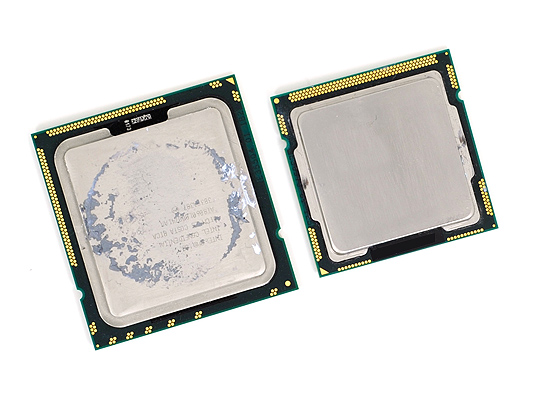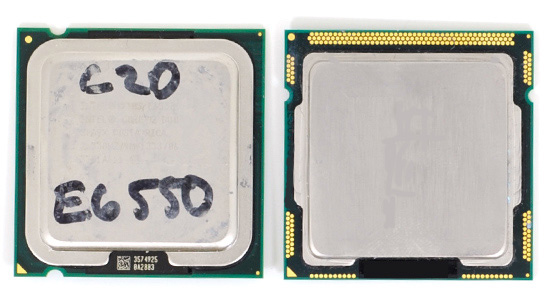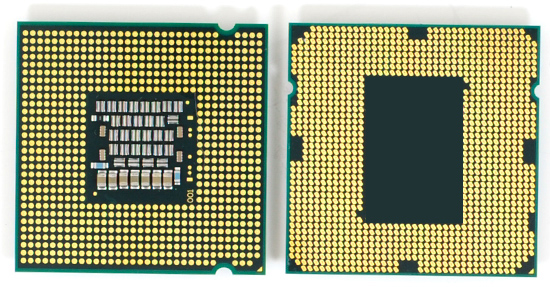The Lynnfield Preview: Rumblings of Revenge
by Anand Lal Shimpi on May 29, 2009 1:00 PM EST- Posted in
- CPUs
The First Lynnfield Sample
Let me preface this with the usual disclaimer. Intel did *not* supply me with this chip and it is most definitely pre-production silicon, not necessarily indicative of final, shipping performance.
With that out of the way, here is Lynnfield:

Lynnfield (front) vs. Bloomfield (back)

Core i7-Bloomfield (left) vs. Lynnfield (right)
It’s a lot smaller than the LGA-1366 Core i7, but compared to current Core 2 Quads it’s actually similar in size:

LGA-775 Core 2 Duo (left) vs. LGA-1156 Lynnfield (right)
Flipping the chips over you see that Lynnfield has a much higher pad density, enabling Intel to fit 1156 pads in about the same space as it fit 775 pads just a few years prior.

Core 2 (left) vs. Lynnfield (right)
Once more, I’ve blanked out all of the caps and other markings on the chip to protect the innocent.
The initial Lynnfield samples were all clocked at 2.13GHz with HT enabled. Turbo mode was also enabled but it too was a meager 2.26GHz regardless of how many cores were active. All of this was to enable motherboard manufacturers to test compatibility and performance of their P55 without giving away Lynnfield’s true performance.
Unfortunately this is the sample I tested with. Thankfully it was healthy enough for me to overclock the BLCK to 166MHz, resulting in a 2.66GHz frequency. Turbo mode was still stuck at a 1x increase over the stock frequency, so final Lynnfield performance should be much better in single and dual threaded apps than what you’ll see here today.
The results on the coming pages show three configurations. Lynnfield running at 2.13GHz with HT enabled, 2.66GHz with HT enabled and 2.66GHz with HT disabled. The latter is going to be the closest to actual Lynnfield performance (albeit still far away thanks the sample’s crippled turbo mode), the 2.66GHz with HT enabled just shows how much we gain from HT and the 2.13GHz chip is an experiment in seeing how low Intel could drop these things and still have a competitive part.
If you thought Nehalem needed Hyper Threading to be a strong performer, you were dead wrong.
Comments About Lynnfield's Readiness
The current rumors in the press are that Lynnfield is being held back in order to clear out excess Core 2 Quad inventory before it ships, because once this thing ships no one is going to want a Penryn anymore. Based on what I've seen, Lynnfield isn't ready just yet - it's not an artificial delay.
The motherboards are in rough shape, CF/SLI isn't working and we're still at very early revs of the CPU's silicon. While I think that the chip will be ready far in advance of its rumored September shipdate, the CPU and motherboards aren't yet.
The Test
Once more: the CPU we've tested here is pre-production silicon without all of its turbo modes enabled. I expect final, shipping performance to be higher in some cases.
| Motherboard: | Pre-release P55 Motherboard (Intel P55) Intel DX58SO (Intel X58) Gigabyte GA-MA790FX-UD5P (AMD 790FX) |
| Chipset: | Intel P55 |
| Chipset Drivers: | Intel 9.1.1.1012 (Intel) AMD Catalyst 8.12 |
| Hard Disk: | Intel X25-M SSD (80GB) |
| Memory: | Qimonda DDR3-1066 4 x 1GB (7-7-7-20) Corsair DDR3-1333 2 x 2GB (7-7-7-20) |
| Video Card: | eVGA GeForce GTX 280 |
| Video Drivers: | NVIDIA ForceWare 180.43 (Vista64) NVIDIA ForceWare 178.24 (Vista32) |
| Desktop Resolution: | 1920 x 1200 |
| OS: | Windows Vista Ultimate 32-bit (for SYSMark) Windows Vista Ultimate 64-bit |










95 Comments
View All Comments
Seramics - Sunday, May 31, 2009 - link
Why is it that in test that demand intensive multi threading, the lynnfield loses out to bloomfield while in less intensive multithreaded or single threaded test, the lynnfield can equal bloomfield? Could it be that in intensive multithreading processing that work up more than 4 threads (thereby requiring the use of HT for better performance), it is able to use the extra memory bandwith provided by triple channel in the bloomfield platform? Maybe in situation where the software can really demand mutlple threading processing intensively, the bloomfield extra memory bandwith provide an edge. An easy way to test this is increasing the memory bandwith of lynnfield and/or decreasing memory bandwith of bloomfield n see wht happens in intensive multithreaded test. Im suspicious of this. Let me know wht u guys thinks.IntelUser2000 - Sunday, May 31, 2009 - link
The Turbo Modes for revealed for Lynnfield way before even Core i7's release.1 core: +5(+4 for non-HT version)
2 core: +3
4 core: +1
It may or may not be coincidence, but the Turbo speed of the highest clock Lynnfield is equal to the Turbo speed of the highest Core i7. The point is, I think since people will overclock the "enthusiast" i7's anyway, the Turbo doesn't need to be so high.
According to Intel, the benefits will be GREATER on smaller form factors, which means laptops will have even HIGHER increases.
RagingDragon - Sunday, May 31, 2009 - link
Hmmm... I'm not sure how much sense Lynnfield will make in the long term - at the high end you'll have Bloomfield on LGA-1366, and at the low end Clarkdale/Arrandale on LGA-1156. I'm not sure if there's enough room between them for Lynnfield, though I guess it does provide an easy upgrade option for inexpensive OEM systems which need to support Clarkdale.brightstar - Sunday, May 31, 2009 - link
I'll wait and see how this pans out, but as of right now the I5 sounds like the new Celery proc to meJS - Saturday, May 30, 2009 - link
"...to protect the innocent"I guess you really wanted to say "to protect my sources". I'm guessing they are not innocent at all, unless you actually stole the stuff from them. ;o)
mybook4 - Saturday, May 30, 2009 - link
The article mentions that Lynnfield will have a new turbo mode that clocks much higher. I was thinking of reasons why intel might put this feature into the mainstream i5 rather than making the feature exclusive to the i7. Then I remembered that the PCIe controller was integrated into the core.To overclock a multiplier locked i5, you would have to increase the base clock. Not sure, but I believe this would also overclock the PCIe controller (something which may not be as tolerant of overclocking).
This might explain why the new high end turbo mode would be included in the i5. You lose high overclocking potential (which would attract overclockers to i7), but in exchange, the i5 does decent overclocking for you.
pyn - Saturday, May 30, 2009 - link
is it possible that we will see turbo modes similar to lynnfield in gulftown? also, is intel going to release any 8 core / 16 thread nehalem processors targeted towards desktop systems or is the nehalem-ex likely to be the only 8 core nehalem we will see?mmpalmeira - Saturday, May 30, 2009 - link
Why did you use the Lynnfield in a 2.66Ghz configuration with HT on if there wont be models like that in the market?Anand Lal Shimpi - Saturday, May 30, 2009 - link
I did that to show what sort of performance having HT enabled is responsible for. Intel isn't making a 2.13GHz HT enabled Lynnfield either, but I ran those tests because they're interesting to look at :)Take care,
Anand
Drazick - Saturday, May 30, 2009 - link
Will the P55 support USB 3, SATA 3, UEFI?When will we see all those features in the chipsets, which for me, are much more important than the i5 by itself.
What about the new Chiopsets, are they SSD optimized?